- Home›
- Healthy Living›
- 8 Yoga Asanas To Help You Lower High Blood Pressure
8 Yoga Asanas To Help You Lower High Blood Pressure
By: Priyanka Maheshwari Mon, 18 Sept 2023 5:42:57
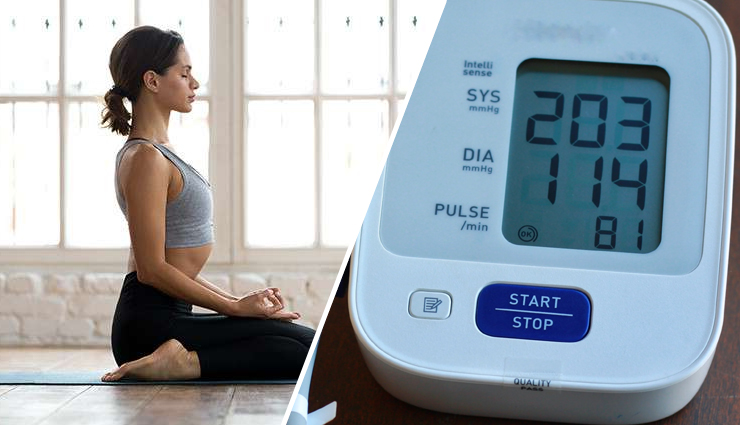
High blood pressure, medically known as hypertension, is a common and potentially serious medical condition that affects millions of people worldwide. It is often referred to as the "silent killer" because it can develop gradually over time without noticeable symptoms, yet it significantly increases the risk of heart disease, stroke, and other health complications. In this introduction, we will explore the basics of high blood pressure, including its definition, causes, risk factors, and the importance of managing and treating it.
High blood pressure is a condition in which the force of blood against the walls of the arteries is consistently too high. Blood pressure is typically measured in millimeters of mercury (mmHg) and is expressed as two numbers: systolic (the higher number) and diastolic (the lower number). Normal blood pressure is usually around 120/80 mmHg, and high blood pressure is generally defined as consistently having readings of 130/80 mmHg or higher.
Several risk factors can increase the likelihood of developing high blood pressure. These include a family history of hypertension, advancing age, obesity or being overweight, a diet high in sodium (salt) and low in potassium, excessive alcohol consumption, smoking, lack of physical activity, and chronic stress.
High blood pressure is a significant health concern because it can lead to severe complications. Over time, the increased pressure on artery walls can damage blood vessels, the heart, and other vital organs. This damage can result in heart disease, heart attacks, strokes, kidney problems, and vision issues.
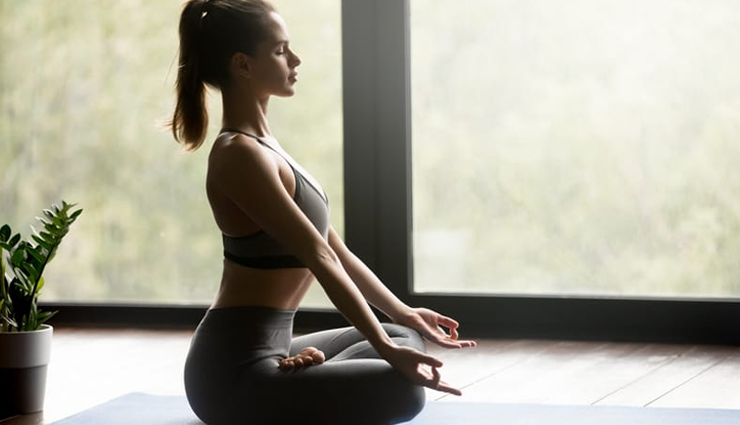
# Sukhasana
Sukhasana, also known as the Easy Pose, is a simple yoga asana that can help relax the body and calm the mind, potentially contributing to lower blood pressure.
- Find a quiet and peaceful place to practice yoga. You can use a yoga mat or a comfortable, clean surface.
- Begin by sitting down with your legs extended straight in front of you.
- Bend your knees and cross your right shin in front of your left shin, allowing your knees to drop toward the floor. Your feet should be beneath the opposite knee.
- Sit evenly on your sitting bones (the bony parts of your pelvis) to create a stable base.
- Lengthen your spine, lifting your chest and rolling your shoulders back. Imagine that a string is pulling the crown of your head toward the ceiling.
- Place your hands on your knees with your palms facing upward. You can use the Chin Mudra by touching the tips of your index fingers to your thumbs, forming a circle, and extending the other fingers.
- Close your eyes or keep them open with a soft gaze. Take deep, slow breaths, focusing on your inhales and exhales. Allow your body and mind to relax.
- Sit in Sukhasana for 5-10 minutes or as long as you're comfortable. During this time, concentrate on your breath and try to let go of any tension or stress.
- To exit the pose, gently uncross your legs and extend them straight in front of you. Shake out your legs if needed to release any stiffness.
- You can repeat Sukhasana as needed or incorporate it into your regular yoga practice to promote relaxation and reduce stress.
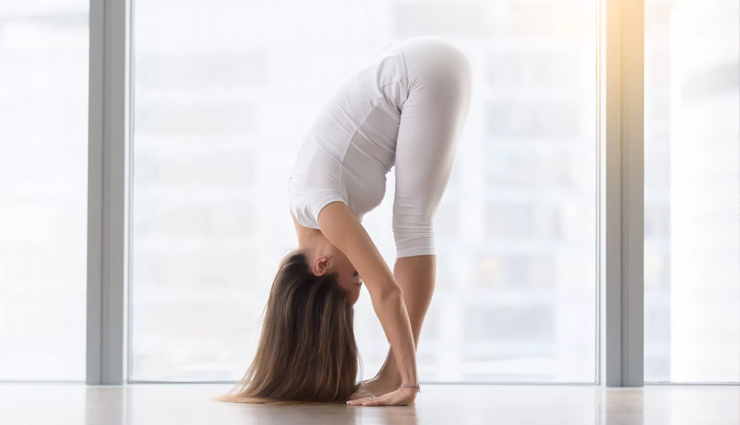
# Uttanasana
Uttanasana, also known as the Standing Forward Bend, is a yoga pose that may help in reducing high blood pressure. Here are the steps to perform Uttanasana:
- Begin in a standing position with your feet hip-width apart and your arms at your sides.
- Take a deep breath in, and as you exhale, start to hinge at your hips, slowly bending forward from your waist. Keep your back straight as long as possible.
- Continue to fold forward, allowing your hands to reach toward the floor. If your flexibility allows, place your hands on the floor beside your feet. If not, you can rest your hands on your shins or thighs.
- Relax your neck and let your head hang down toward the floor. Feel the stretch along the back of your legs and your lower back.
- Keep your knees slightly bent if you feel any discomfort in your hamstrings. You can gradually work toward straightening your legs as your flexibility improves.
- Breathe deeply and hold the pose for 15-30 seconds, gradually increasing the duration as you become more comfortable.
- To come out of the pose, bend your knees slightly, engage your core, and slowly roll up to a standing position, one vertebra at a time. Keep your head and neck relaxed as you rise.
- Return to the starting position with your feet hip-width apart and your arms at your sides.
- You can repeat Uttanasana 2-3 times, allowing your body to relax and release tension with each repetition.
- Practice this asana regularly as part of your yoga routine to experience its potential benefits for reducing high blood pressure.
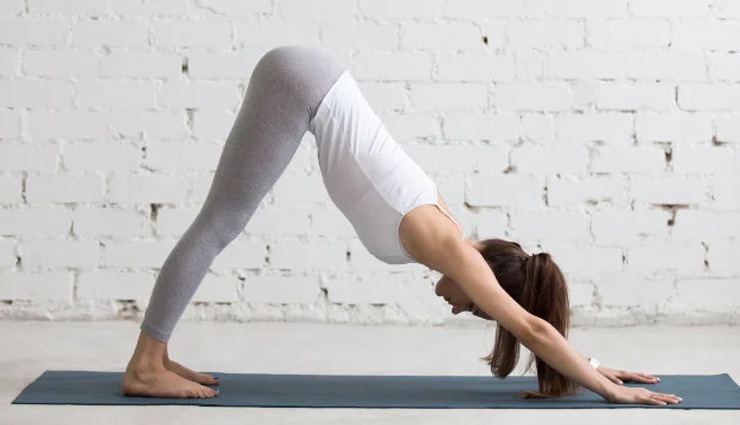
# Adho Mukha Svanasana
Adho Mukha Svanasana, also known as Downward-Facing Dog Pose, is a yoga pose that may help in reducing high blood pressure. Here are the steps to perform Adho Mukha Svanasana:
- Start on your hands and knees in a tabletop position, with your wrists aligned under your shoulders and your knees under your hips.
- Spread your fingers wide and press your palms firmly into the mat. Your fingers should be pointing forward, and your hands should be shoulder-width apart.
- Tuck your toes under and, on an exhale, lift your knees off the mat, straightening your legs as you come into an inverted V-shape.
- Your body should resemble an upside-down "V." Keep your arms and legs straight, but don't lock your elbows or knees. Engage your quadriceps to gently lift your kneecaps.
- Press your heels toward the floor. They may not touch the mat entirely, which is okay. The goal is to create length and stretch in your spine and the backs of your legs.
- Engage your core muscles by drawing your navel toward your spine. This helps support your lower back.
- Relax your head and neck, letting them hang naturally between your arms. Your ears should be in line with your upper arms.
- Breathe deeply and hold the pose for 30 seconds to 1 minute, gradually increasing the duration as you become more comfortable.
- To release the pose, exhale as you gently bend your knees and lower them back to the mat, returning to the tabletop position.
- Take a moment to rest in Child's Pose (Balasana) or the tabletop position to allow your body to recover.
- You can repeat Adho Mukha Svanasana 2-3 times, focusing on your breath and relaxation with each repetition.
- Practice this asana regularly as part of your yoga routine to experience its potential benefits for reducing high blood pressure.
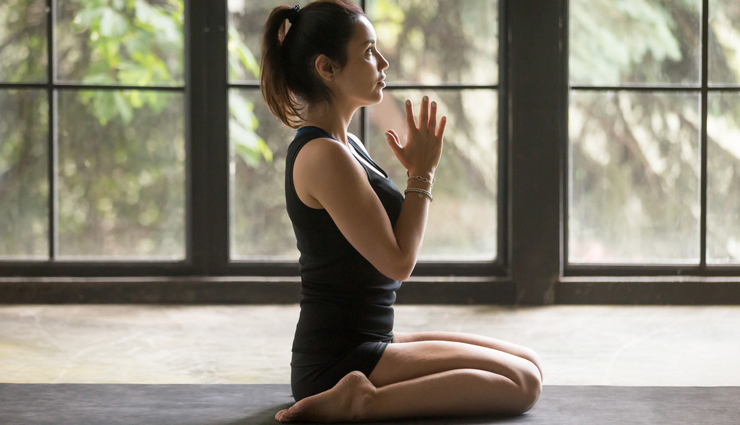
# Virasana
Virasana, also known as Hero Pose, is a yoga pose that can help reduce high blood pressure. Here are the steps to perform Virasana:
- Start by kneeling on the floor with your knees together and your big toes touching. Your feet should be flat on the floor, and your buttocks should rest on your heels.
- Keep your spine straight and place your hands on your thighs, palms facing down.
- Take a few deep breaths to relax and settle into the pose.
- On an exhale, begin to separate your feet slightly wider than hip-width apart. Gently sit back on the floor or a cushion placed between your feet.
- As you lower yourself down, maintain a straight back and engage your core muscles. This will help protect your lower back and provide support.
- Once you are seated comfortably between your feet, you can rest your hands on your thighs or in your lap with your palms facing up.
- Close your eyes and take slow, deep breaths. Focus on your breath and try to relax your body.
- Hold Virasana for 1-5 minutes, or as long as is comfortable for you. You can gradually increase the duration as your flexibility improves.
- To release the pose, place your hands on the floor behind you and gently lift your hips off your heels. Return to the initial kneeling position.
- Stretch your legs out in front of you and shake them out to release any tension.
- You can repeat Virasana as part of your regular yoga practice to help manage high blood pressure and promote relaxation.
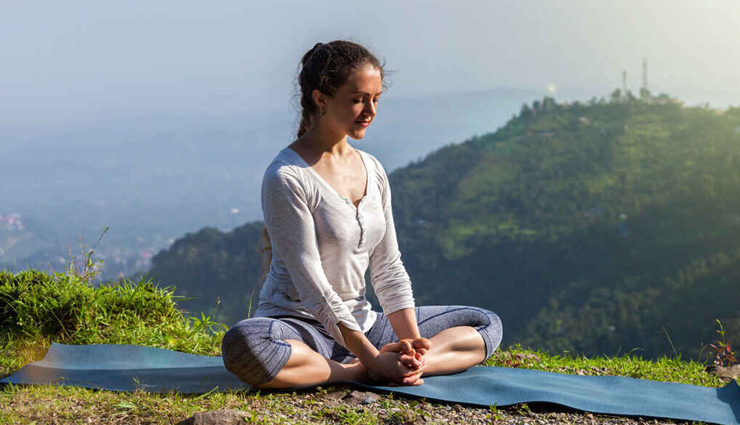
# Baddha Konasana
Baddha Konasana, also known as Bound Angle Pose or Butterfly Pose, is a yoga pose that can be beneficial for reducing high blood pressure. Here are the steps to perform Baddha Konasana:
- Start by sitting on the floor with your legs extended straight in front of you.
- Take a few moments to sit tall and lengthen your spine, keeping your shoulders relaxed.
- Bend your knees and draw your heels toward your pelvis.
- Allow your knees to fall outward to the sides, bringing the soles of your feet together. Your feet should be close to your pelvis, and your knees should be wide apart.
- Hold onto your feet or ankles with your hands. You can loop your index and middle fingers around your big toes if you prefer.
- Sit up straight and engage your core muscles to support your lower back.
- Take a deep breath in, and as you exhale, gently press your knees toward the floor. Use your elbows to apply gentle pressure on your thighs if needed to encourage them to move closer to the ground.
- Keep your feet flexed, and the outer edges of your feet should remain on the floor.
- Lengthen your spine with each inhale and deepen the stretch with each exhale.
- Hold Baddha Konasana for 1-5 minutes, breathing deeply and relaxing into the pose.
- To release the pose, inhale and lift your knees back to the center. Straighten your legs and shake them out to release any tension.
- You can repeat Baddha Konasana as part of your regular yoga practice to help manage high blood pressure and promote relaxation.
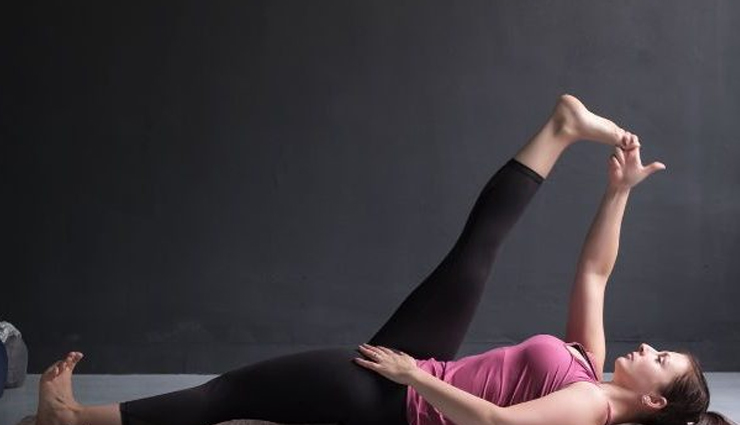
# Supta Padangusthasana
Supta Padangusthasana, also known as Reclining Hand-to-Big-Toe Pose, is a yoga pose that can help reduce high blood pressure. Here are the steps to perform Supta Padangusthasana:
- Start by lying flat on your back on a yoga mat or a comfortable surface. Extend your legs fully, keeping them together.
- Relax your arms by your sides, palms facing down. Take a moment to settle into a comfortable and relaxed position.
- Take a deep breath in to prepare.
- Exhale and bend your right knee toward your chest. Hug your right knee with both hands, interlocking your fingers just below your kneecap.
- Keep your left leg extended and active, pressing the left thigh into the floor. Ensure that your left heel is in contact with the mat.
- On an exhale, begin to straighten your right leg toward the ceiling. Keep your leg as straight as possible without forcing it. You can use a yoga strap around your foot if needed to reach your toes.
- Flex your right foot, drawing your toes toward your body. This helps to engage your leg muscles and keep the leg active.
- Maintain your left leg pressed into the floor to stabilize your pelvis.
- Relax your shoulders and neck on the mat, keeping your upper body relaxed.
- Breathe deeply and hold Supta Padangusthasana for 30 seconds to 1 minute, or as long as is comfortable for you. Focus on your breath and try to release any tension in your body.
- To release the pose, bend your right knee and gently lower your right foot to the floor.
- Repeat the pose on the opposite side by bending your left knee and straightening your left leg.
- After completing both sides, you can draw both knees to your chest and hug them for a moment to release any remaining tension.
- Finally, extend both legs out and relax in Savasana (Corpse Pose) for a few breaths.
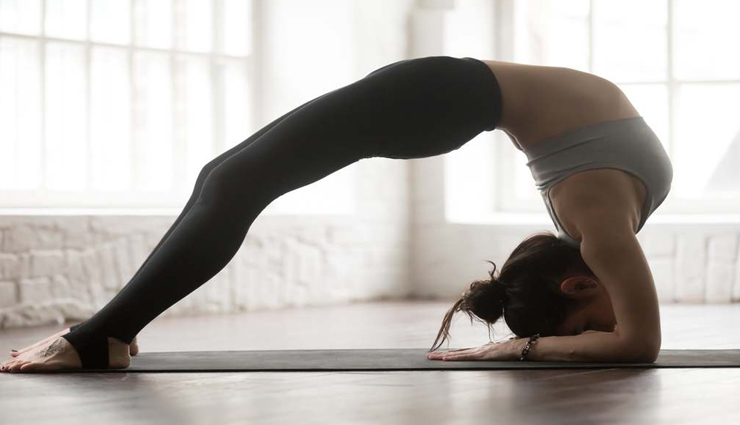
# Setu Bandhasana
Setu Bandhasana, also known as Bridge Pose, is a yoga pose that can be beneficial for reducing high blood pressure. Here are the steps to perform Setu Bandhasana:
- Begin by lying flat on your back on a yoga mat or a comfortable surface. Bend your knees and place your feet flat on the floor, hip-width apart.
- Relax your arms by your sides, with your palms facing down. Your fingertips should lightly touch your heels.
- Take a moment to settle into a comfortable and relaxed position.
- On an exhale, engage your core muscles and press your feet into the floor. Begin to lift your hips off the mat, creating a bridge shape with your body.
- As you lift your hips, try to keep your thighs parallel to each other. Avoid letting your knees splay outward or inward.
- Press your shoulders, arms, and feet into the ground to support the lift of your hips.
- Roll your shoulders underneath you, tucking your shoulder blades toward each other. This action helps open your chest.
- Keep your chin slightly tucked to maintain a natural alignment of your neck.
- Breathe deeply and hold Setu Bandhasana for 30 seconds to 1 minute, or as long as is comfortable for you. Focus on your breath and try to release any tension in your body.
- To release the pose, gently lower your spine and hips back to the mat, one vertebra at a time.
- Extend your legs out and relax in Savasana (Corpse Pose) for a few breaths to allow your body to recover.
- You can repeat Setu Bandhasana 2-3 times, focusing on your breath and relaxation with each repetition.
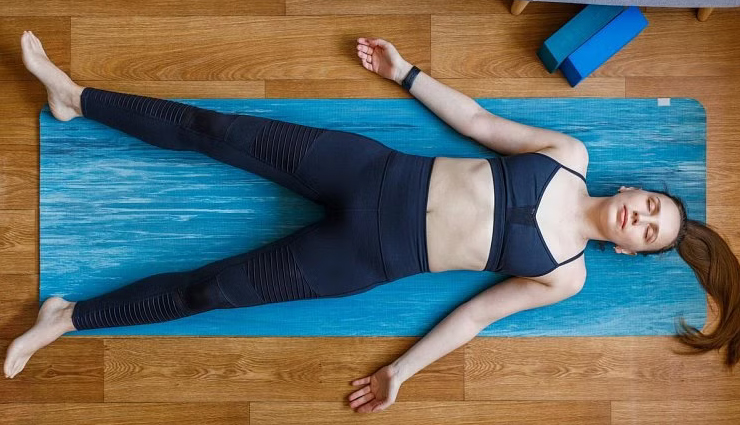
# Shavasana
Shavasana, also known as Corpse Pose, is a yoga pose that promotes relaxation and can help reduce high blood pressure. Here are the steps to perform Shavasana:
- Start by lying down on your back on a yoga mat or a comfortable surface.
- Allow your legs to relax and spread slightly apart, with your feet falling naturally to the sides.
- Place your arms alongside your body, a few inches away from your torso, with your palms facing up.
- Close your eyes gently. Soften your facial muscles, including your jaw and forehead.
- Take a deep breath in through your nose, allowing your abdomen to rise as you fill your lungs with air.
- Exhale slowly and completely through your nose, letting go of any tension in your body.
- Continue to breathe naturally and comfortably, focusing on your breath. Pay attention to the rise and fall of your chest and abdomen with each breath.
- As you inhale, imagine a sense of calmness and relaxation filling your body.
- As you exhale, release any stress, tension, or worries from your mind and body.
- Start at the top of your body and mentally scan down to your toes, consciously relaxing each body part as you go.
- Let go of any thoughts, distractions, or mental chatter. If thoughts arise, acknowledge them and gently bring your focus back to your breath and the present moment.
- Remain in Shavasana for 5-10 minutes or longer if you wish. The longer you can stay in this pose, the deeper the relaxation.
- To come out of Shavasana, begin to deepen your breath. Slowly wiggle your fingers and toes, awakening your body.
- Gently roll onto your right side into a fetal position, using your right arm as a pillow for your head.
- Take a few breaths in this fetal position before slowly sitting up.
- Open your eyes and take a moment to reorient yourself to the surroundings.
- You can conclude your practice by thanking yourself for taking this time to relax and reduce stress.





